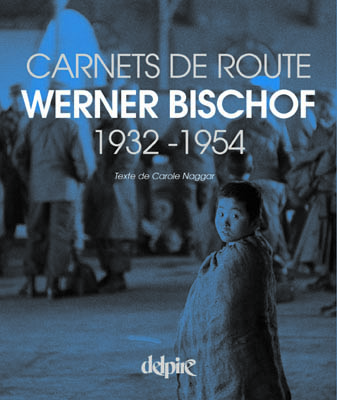Werner BISCHOF
Editeur : Delpire
Année de parution : 2008
Pour qui sait que Werner Bischof a été l’élève le plus brillant de la Kunst Gewerbe Schule de Zurich, pour qui a vu les premiers travaux, ses jeux subtils de lumière, ses portraits et ses nus, c’est sans doute surprenant de découvrir ses premiers reportages sur l’Europe d’après guerre.
Mais, grâce au directeur de la revue DU qui les lui a commandés, Werner Bischof a circulé, dès l’immédiate après-guerre, en Allemagne sinistrée par les bombardements, en Hongrie, en Pologne, dans tous ces pays dévastés, peuplés d’individus faméliques, qui ont montré à ce photographe privilégié d’avoir vécu sa jeunesse en Suisse, ce qu’était la misère la plus atroce et la perte de leur dignité.
Il continuera dans cette voie en Inde et au Vietnam pour retrouver enfin, au Japon, qui fut sa terre d’élection, une tradition d’une richesse qui le comblait, une culture d’une finesse et d’une variété qui n’ont pas d’équivalent. Entre les paysages, et les jardins zen, l’architecture, le souci affiné du décor, et jusqu’à l’écriture, il a trouvé là matière à sa curiosité.Un sens plastique indéniable, une compassion sans mièvrerie, placent d’évidence Werner Bischof, malgré sa courte vie – il se tua à 38 ans dans les Andes péruviennes -, parmi les grands photographes de son temps.
Robert Delpire
Puis la guerre est venue, et avec elle la destruction de ma »tour d’ivoire ».
Le visage de l’homme souffrant est passé au premier plan. J’ai travaillé comme correspondant à la frontière austro suisse et j’ai vu des milliers d’êtres humains échoués là, qui attendaient pendant des jours et des semaines derrière les barbelés. Des enfants et des vieillards; dans leurs dos des explosions de grenades et des blindés en folie.
Il fallait que je parte, que j’apprenne à connaître le véritable visage du monde. Notre petite vie confortable empêchait un grand nombre de gens de voir l’immense détresse en dehors de nos frontières. On versait sa contribution aux oeuvres d’entraide humanitaire, ainsi l’on se sentait dispensé de toute réflexion.
Après mon premier voyage en Hollande, en France, au Luxembourg, la revue DU publia mes impressions. Mais quelle indignation! La photo de la page de titre avec le visage détruit, blessé, de l’enfant avait effrayé les gens qui voulaient avoir la paix.
A la maison, j’ai regardé avec mélancolie les photos délicates que j’avais faites avant la guerre et qui m’avaient valu tant de louanges de la part de mon entourage – mais dans mon esprit je voyais les centaines de milliers de malheureux anéantis par la misère quotidienne et qui avaient besoin de notre aide.
Werner Bischof, Autobiographie
Images After the War
For those who know that Werner Bischof was the most brilliant student at the
Kunst Gewerbe Schule in Zurich, for those who saw his early work with his subtle play of light and his portraits and nudes, it is no doubt surprising to discover his first documentaries on post-war Europe.
Due to the commission he recieved from the magazine ‘DU’, Werner Bischof travelled immediately after the war to a Germany stricken by the bombings as well as Hungary and Poland. In all these devastated countries he found emaciated individuals, showing this privileged photographer who spent his youth in Switzerland, what atrocious misery and loss of dignity was possible.
He would continue in this direction into India and Vietnam to finally find himself in Japan which became his chosen land, a country rich in tradition and a culture of finesse and variety that has no equivalent. Between landscapes and zen gardens, architecture, refined decor, and in writing, he found the subject matter for his curiosity. An undeniable sense of form and a compassion without sentimentality, Werner Bischof, despite his short life- he was killed at 38 years old in the Peruvian Andes- was among the greatest photographers of his time.
Robert Delpire
Then the war came, and with it the destruction of my ‘ivory tower’.
The face of human suffering has risen to the forefront. I worked like a correspondent at the Swiss / Austrian border and saw thousands of people stranded there, waiting for days and weeks behind barbed wire. Children and the elderly, in their backs explosions of grenades and madness.
I had to leave in order to know the true face of the world. Our small comfortable life prevented many people from seeing the immense distress outside our borders. We paid our contribution to organisations giving humanitarian assistance and felt relieved of the need for any reflection.
After my first trip to Holland, France and Luxembourg, the magazine published ‘DU’ my impressions. But what outrage! The photo on the cover page of the injured child with his face destroyed frightened people who wanted peace.
At home, I looked with melancholy at the delicate pictures that I made before the
war and which earned me so much praise from my family and friends – but in my mind I saw hundreds of thousands of the unfortunate crushed by daily misery and who needed our help.
Werner Bischof, Autobiography

Lettre d’information
75004 Paris – France
+33 (0)1 42 74 26 36
ouverture du mercredi au samedi
de 13h30 à 18h30. Entrée libre
M° Rambuteau – Les Halles
Pour Que l’Esprit Vive
20 rue Lalande
75014 Paris – France
T. 33(0)1 81 80 03 66
www.pqev.org

